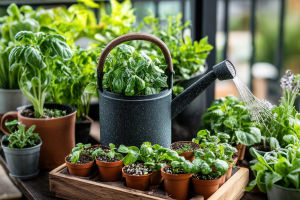Moonlight Fragrant Bloom
Lykkers, have you ever walked through a garden and noticed a flower that seems shy during the day, only to come alive at night? That's the tuberose, also known scientifically as "Polianthes tuberosa" or "Agave amica."
This perennial bulb plant is part of the Asparagaceae family and is celebrated around the world for its stunning white blooms and intoxicating scent.
Unlike most flowers that rely on sunlight for attention, tuberose blooms under the moonlight, offering a magical experience for anyone willing to wait until evening.
What Makes Tuberose Unique
The tuberose grows from bulbous roots, sending up long, narrow leaves that form dense green clusters. Its flower stalks are tall and elegant, each ending in a spike full of creamy white flowers. During summer and autumn, these buds slowly open as dusk falls, and by night, their scent fills the air.
Unlike daytime flowers that attract pollinators visually, tuberose relies on fragrance to lure nocturnal visitors like moths. This adaptation makes it not only beautiful but also fascinating from a biological perspective.
The Cultural and Symbolic Charm
In some parts of South Asia, the tuberose is affectionately called "night-blooming jasmine," meaning "Queen of the Night." This title perfectly captures its mysterious elegance.
We can imagine walking through gardens where clusters of tuberose glow subtly in moonlight, each flower releasing a sweet scent that makes the night feel almost magical.
Best Time to Observe Tuberose
If we want to see the tuberose at its peak, summer and autumn evenings are ideal. Around dusk, the buds slowly begin to unfurl, and by late evening, the fragrance becomes nearly intoxicating. The experience is both visual and sensory: delicate white petals against a dark sky, combined with a scent that seems to grow stronger with each passing hour.
Approaching these flowers quietly allows us to fully appreciate the elegance and fragility of the blooms. Each spike of flowers is a small masterpiece of nature.
Growing Tuberose at Home
For garden lovers, adding tuberose can be incredibly rewarding. The plant thrives in well-drained soil and needs sunlight during the day to fuel its nighttime display. Planting bulbs in clusters not only creates a more dramatic visual effect but also enhances the intensity of the fragrance.
Watering should be moderate, as too much moisture can damage the bulbs. For the full experience, we can make evening walks through the garden a ritual, pausing to enjoy the scent and admire the flowers' delicate shapes.
Why Night-Blooming Flowers Fascinate Us
Tuberose teaches us that nature's beauty isn't always immediate. While daytime flowers dazzle with color, night-bloomers remind us that some treasures are revealed only if we slow down and pay attention. Lykkers, taking a moment after sunset to observe these flowers can be a surprisingly serene and uplifting experience.
Their intoxicating aroma and soft, white petals show us that the night holds its own magic.
Connecting with Nature Through Tuberose
Walking among tuberose flowers at night can feel like stepping into another world. The combination of tall white spikes, clusters of delicate petals, and a heady fragrance creates a sensory journey that engages both sight and smell.
For those of us who love gardening or simply spending time in nature, observing tuberose is a gentle reminder to embrace patience and curiosity. Nature often rewards those who slow down.
Wrapping Up Our Floral Adventure
Exploring tuberose shows us how even the quietest plants can make a profound impact. From the strength of its bulb to the elegance of each flower spike, tuberose is a masterpiece of nature's design. As we admire the nighttime bloom and inhale its sweet scent, we carry a little piece of that magic with us.
Lykkers, next time we stroll under the moonlight, let's keep an eye out for these exquisite night blooms. Their beauty is subtle, their fragrance intoxicating, and their presence a reminder that nature often surprises us when we least expect it.
Tuberose: Fragrance from Heaven!
Video by UMDHGIC
-
 Shy BloomUp Close with the "Shy Bloom": See the Secret Details of Mimosa pudica Flowers Like Never Before!
Shy BloomUp Close with the "Shy Bloom": See the Secret Details of Mimosa pudica Flowers Like Never Before! -
 Balcony Veggie GardenHow to Grow Fresh Vegetables on Your Balcony — A Simple and Rewarding Urban Gardening Guide!
Balcony Veggie GardenHow to Grow Fresh Vegetables on Your Balcony — A Simple and Rewarding Urban Gardening Guide! -
 Flight of BeautyExplore the vibrant colors and unique shape of the Bird of Paradise flower!
Flight of BeautyExplore the vibrant colors and unique shape of the Bird of Paradise flower!
Copyright © zogu 2021 - 2025. All Right Reserved.